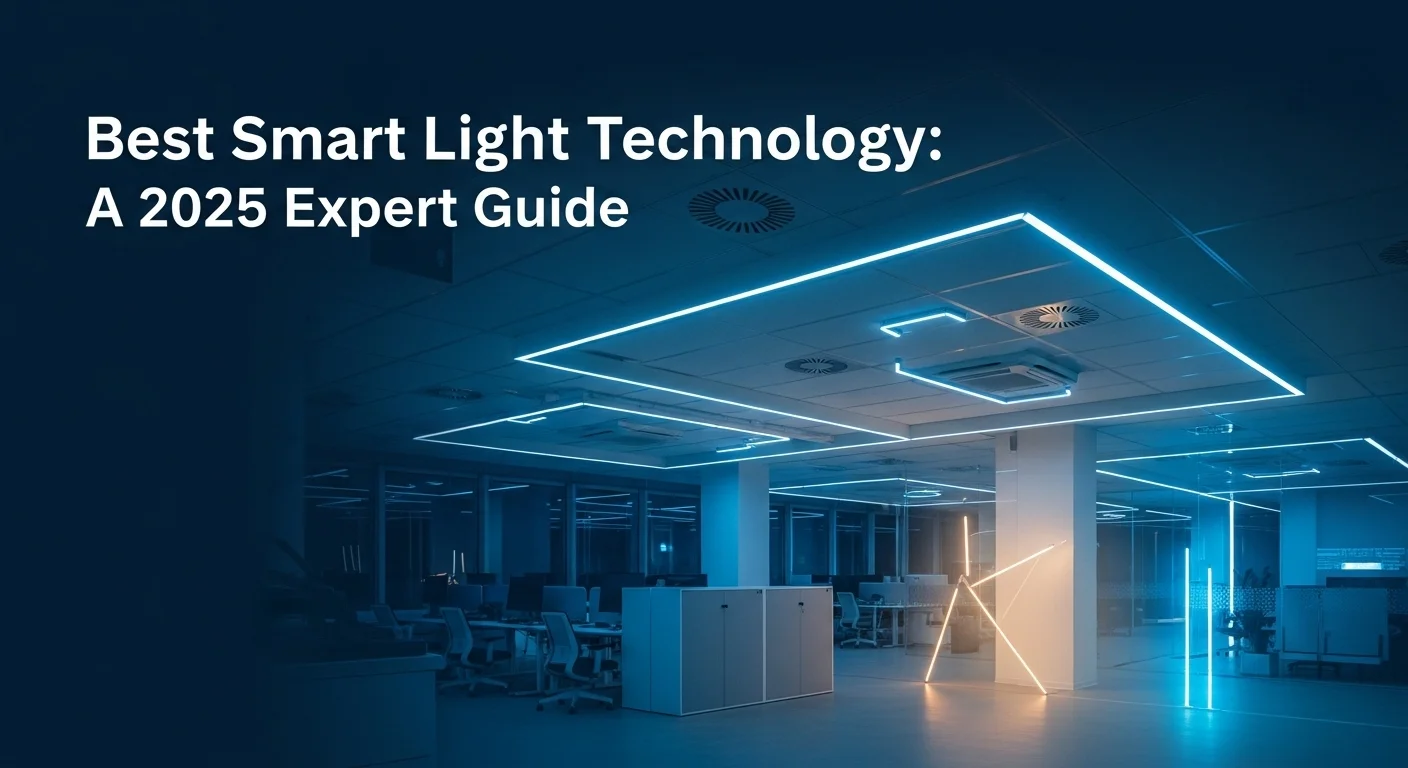Choosing the Best Smart Lights in 2025: My Hands-On Expert Guide

Executive Summary
In my years as a smart home integrator, I've seen smart lighting evolve from a fun gimmick to a truly essential part of modern homes and businesses. It's one of the most impactful upgrades you can make. This guide is a distillation of my hands-on experience. We'll cut through the jargon and explore what really matters, from the different ways these lights 'talk' to each other—like Wi-Fi, Zigbee, and the game-changing Matter standard—to the real-world benefits. For homeowners, it's about creating moods, boosting security, and pure convenience. For business owners, it's a powerful tool for saving money on energy and creating spaces that make employees and customers happier. I'll give you my honest take on the top brands, help you understand control systems, and share strategies to get the absolute most out of your investment. Whether you're just starting out or looking to upgrade, this guide will light the way.
Table of Contents
What is Smart Lighting, Really?
Let's simplify this. Smart lighting is more than just a fancy light bulb; it's a huge leap in how we interact with light itself. Think of it like this: a regular bulb is tied to a physical switch on the wall. A smart light takes that switch, adds a dimmer, a color wheel with millions of options, and a timer, and puts it all into an app on your phone or under the command of your voice. At its heart, a smart light has a tiny computer chip inside that lets it connect to a network. That connection is what makes it 'smart,' giving you the power to control, automate, and customize your lighting from anywhere. After installing hundreds of these systems, I can tell you it's a pivotal piece of the Internet of Things (IoT) puzzle, making our homes and offices more efficient, secure, and enjoyable places to be.
The Core Technology: How These Lights Actually Communicate
To pick the right system, you first need to understand how they talk. It's less complicated than it sounds. These are the main 'languages' they use:
- Wi-Fi: This is the simplest path. The bulb connects directly to your home's Wi-Fi router, just like your laptop or phone. No extra hardware needed. It's why I often recommend brands like Govee or LIFX for beginners. The only catch? If you add too many Wi-Fi devices, you can sometimes crowd your network, which might slow things down.
- Bluetooth: This lets you control lights directly from your phone when you're nearby. It's great for a single room and doesn't touch your Wi-Fi at all. Many Philips Hue bulbs now include Bluetooth as a starting point, so you can try them out before committing to their hub.
- Zigbee and Z-Wave: These are my go-to for larger, more serious setups. They are low-power networks designed just for smart devices. Instead of everything hitting your router, the devices create their own 'mesh' network, talking to each other. Every bulb you add actually makes the network stronger and extends its range. It's incredibly reliable. The trade-off is that you need a 'hub' or 'bridge' (like the Philips Hue Bridge) to act as a translator between the Zigbee network and your router.
- Matter: This is the future, and frankly, I've been waiting for it for years. Think of Matter as a universal translator. It's a new standard created by all the big players (Apple, Google, Amazon, Philips) to make devices from different brands work together without a fuss. Nanoleaf is a pioneer here, building their products to be Matter-ready from the get-go. This means you'll spend less time worrying about compatibility and more time enjoying your smart home.
Why Smart Lighting is a Game-Changer for Homes and Businesses
The real value goes way beyond changing colors. It's about tangible improvements to daily life and business operations.
1. Effortless Convenience and Control
This is the benefit you feel immediately. Turning off every light in the house from your bed, or scheduling your porch light to turn on at sunset automatically—it's a small luxury that makes a big difference. For a business, imagine a facility manager controlling the lights for an entire building from a single screen. It's not just convenient; it's a massive time-saver.
2. Serious Energy Efficiency and Cost Savings
Smart lights almost exclusively use hyper-efficient LEDs, which already slash energy use. But the 'smart' part is what takes it to the next level. Scheduling ensures lights aren't left on in empty rooms. Motion sensors in offices or warehouses can save a fortune by only lighting spaces when they're in use. I've seen businesses cut their lighting-related energy costs by over 50% just by implementing these basic automations. That money goes straight back to the bottom line.
3. Real Security and Peace of Mind
This is a big one for my clients. A smart home looks like an occupied home. The 'vacation mode' on many systems will randomly turn lights on and off to make it look like someone's there, which is a far better deterrent than a simple timer. You can also link lights to your security cameras, so if motion is detected in the backyard, the floodlights instantly blast on. It's a simple, effective layer of security.
4. Perfecting Ambiance and Promoting Wellness
This is the fun part. You can craft lighting 'scenes' for any activity: bright, cool light for focus when you're working from home, and a warm, dim glow for relaxing with a movie. It's not just about mood, either. We're now installing 'circadian rhythm' systems that mimic natural daylight, providing energizing light in the morning and warm, sleep-promoting light at night. In an office, this has been shown to improve focus and employee well-being.
5. A Competitive Edge for Businesses
A smart lighting system is a strategic asset.
- In retail, you can use dynamic lighting to spotlight new products or create an unforgettable in-store vibe that sets you apart from online shopping.
- In hospitality, hotels and restaurants use it to craft the perfect atmosphere, from a bright, welcoming lobby to an intimate dining experience.
- In offices, beyond energy savings, a tech-forward, comfortable environment helps attract and keep great employees.
Smart lighting has truly come of age. It’s a core technology that delivers on its promises of a smarter, more efficient, and more enjoyable world. As we move forward, especially with AI and Matter becoming mainstream, its role will only become more central.

Complete Guide to the Best Smart Lights: A Brand Showdown and Business Solutions
Choosing the right smart lighting system can feel overwhelming. I've installed and tested them all, so let me break down the major players and help you figure out which one is the best fit for your home or business. It's all about matching the brand's strengths to your specific needs.
Comparing the Titans: My Personal Take on the Top Brands
A few brands consistently rise to the top. Here's who I recommend and why.
1. Philips Hue
Let's be clear: Philips Hue is the gold standard, the Apple of smart lighting. I recommend it when reliability and a massive ecosystem are the top priorities.
- Ecosystem & Product Range: Simply unbeatable. They have a bulb for every socket imaginable, plus amazing lightstrips, outdoor fixtures, and unique gadgets like the Play HDMI Sync Box that matches your lights to your TV. The hardware and software quality is second to none.
- Technology: It's built on the ultra-reliable Zigbee protocol, which does mean you need the Hue Bridge for all the cool features. But trust me, the stability is worth it. Newer bulbs also have Bluetooth, so you can start without the bridge and add it later.
- Price: Premium. You're paying for the quality and the name, and it can add up quickly.
- My Verdict: If you want the best all-around system that will grow with you and 'just work,' and you have the budget, Hue is the one. It's the system I use in my own home.
2. Govee
Govee has completely shaken up the market. They are the champions of fun, creative, and affordable lighting.
- Ecosystem & Product Range: Govee is all about creative expression. They're famous for their RGBIC lightstrips that can show multiple colors at once, their TV backlights that use a camera to sync with the screen, and all sorts of wild decorative lights.
- Technology: Most of their gear runs on Wi-Fi, so there's no hub needed. This makes setup incredibly easy and keeps the initial cost low.
- Price: This is their killer feature. Govee offers incredible value, often at a fraction of the price of Hue.
- My Verdict: If you're on a budget, a gamer, or someone who loves vibrant, dynamic color effects, Govee is a fantastic choice. Their app gives you endless ways to play with your lighting.
3. Nanoleaf
Nanoleaf is for the artist and the tech-forward user. They turned lighting into wall art.
- Ecosystem & Product Range: Known for their modular light panels—Shapes, Lines, Blocks—that you can arrange into your own custom designs. They also offer excellent standard bulbs and lightstrips.
- Technology: Nanoleaf is all-in on the future. They are a leader in adopting the Matter standard and use a speedy mesh network called Thread. This makes their products incredibly responsive and ready for the interconnected smart home of tomorrow.
- Price: It's a premium product, especially the panel kits, but you're buying a design centerpiece.
- My Verdict: If you want your lighting to be a conversation starter and a piece of decor, Nanoleaf is the best choice. Their commitment to Matter also makes them a smart long-term investment.
4. Lutron
While others focus on the bulb, Lutron masters the switch. For rock-solid, whole-home control, they are in a class of their own.
- Ecosystem & Product Range: Their Caséta line of in-wall smart dimmers and switches is legendary among professional installers. It lets you make all your existing light fixtures smart, regardless of the bulbs.
- Technology: They use their own super-reliable Clear Connect RF technology that won't interfere with your Wi-Fi. A smart bridge is required, but its performance is flawless.
- Price: It's an investment, but you're paying for unparalleled reliability.
- My Verdict: For new builds, renovations, or anyone who wants the most dependable smart lighting control system on the market, Lutron is the professional's choice.
5. Wyze, Sengled, and LIFX
These are strong contenders too. Wyze is my go-to recommendation for anyone wanting to try smart tech on an absolute shoestring budget. Sengled offers a wide range of affordable bulbs for different systems. LIFX remains a great hub-less option, known for its exceptionally bright and vivid bulbs.
The Brains of the Operation: Understanding Control Systems
How you control the lights is half the battle. Let's break down the core concepts.
Hub vs. Hub-less
- Hub-less (Wi-Fi/Bluetooth): Think of this as every light having its own direct line to your Wi-Fi router. It's simple and cheap to start. The downside is that with too many devices, you can create a traffic jam on your Wi-Fi 'highway.'
- Hub-based (Zigbee/Z-Wave): A hub acts like a dedicated traffic controller. It creates a separate, private road just for your smart devices, so they communicate flawlessly without clogging up your main Wi-Fi. It's an extra piece of kit, but for any setup with more than 10-15 bulbs, it's the more reliable and robust choice.
The Power of Smart Home Platforms
While each brand has its own app, the real magic happens when you unite everything under one roof with Amazon Alexa, Google Home, or Apple HomeKit. Compatibility with your chosen platform is non-negotiable. This lets you:
- Use Your Voice: Saying 'Hey Google, set the living room to movie night' is a feature you'll use every single day.
- Build Powerful Routines: A 'Good Morning' routine can slowly fade up your lights, start the coffee maker, and play the news, all with a single command.
- Control Everything in One Place: No more jumping between five different apps. You get a central dashboard for your entire smart home.
Solutions for Business and Commercial Spaces
When you're lighting a business, the priorities shift to scale, management, and data.
- Commercial-Grade Systems: Companies like Lutron and Crestron offer systems designed to manage thousands of lights across huge facilities. They're built for mission-critical reliability.
- Building Management Integration: The biggest advantage for large businesses is integrating lighting with other building systems like HVAC. Occupancy sensors in the lights can tell the heating system that a certain floor is empty, preventing massive energy waste.
- Data and Analytics: Commercial systems give you a dashboard showing energy use, peak traffic times in different zones, and which lights need maintenance. This data is gold for optimizing operations and cutting costs.
Ultimately, picking the best system is a personal choice. A Govee strip might be perfect for your kid's room, while a Lutron system is ideal for your new kitchen renovation. By understanding these brands and concepts, you can confidently choose the system that will best light up your world.

Pro Tips: How to Get the Most Out of Your Smart Lights
Getting a box of smart bulbs is the easy part. The real fun begins when you learn how to use them strategically to make your life easier and your home feel more alive. As someone who lives and breathes this stuff, here are my top tips and strategies for both homeowners and businesses.
Best Practices for Your Smart Home
Think of your lights as an active part of your home's personality, not just a utility.
1. Plan Your Zones and Scenes Like a Designer
Don't just replace bulbs; think about activities. Your living room isn't just one room—it's a home theater, a reading nook, and a place to entertain. In your app, create 'scenes' for these moments.
- My 'Movie Night' Scene: The main overhead lights dim to 10%, the lightstrip behind my TV glows a soft blue to reduce eye strain, and the two corner lamps provide a warm, gentle accent. All with one tap.
- 'Focus' Scene for Work: When I'm at my desk, my main light shifts to a bright, cool white (around 4500K). It's amazing how much it helps with alertness.
- 'Relax' Scene for Evenings: After dinner, a single command shifts all the lights in my living space to a warm, candle-like glow (around 2200K). It's an instant signal to my brain to start winding down.
2. Let Automation Do the Work for You
The best smart home is one you don't have to think about. Set up automations and let them run your life.
- The Sunrise Alarm: This is a non-negotiable for me. My bedroom lights start to glow warmly 20 minutes before my alarm goes off, gradually brightening to mimic a sunrise. It's a much more peaceful way to wake up.
- Geofencing: This is magic. The system uses my phone's location. When I pull into my driveway, the porch and entryway lights turn on automatically. When I leave, it checks if any lights were left on and turns them off.
- Motion Sensors are Your Friend: I have them in my hallway, laundry room, and garage. Lights turn on when I walk in and off a few minutes after I leave. It's perfect for when your hands are full.
3. Take Cybersecurity Seriously (It's Easy)
Any device on your network is a potential door. Locking that door is simple.
- Use a Strong Wi-Fi Password: If your password is 'password123', please change it right now. Use a long, random mix of characters.
- Create a Guest Network: Most modern routers let you create a separate 'guest' network. I put all my smart home gadgets—lights, plugs, speakers—on this network. It isolates them from my personal computer and phone, adding a great layer of security.
- Keep Everything Updated: When you see an alert to update the firmware on your lights, hub, or router, do it. These updates often contain vital security fixes.
- Stick to Trusted Brands: I trust companies like Philips Hue, Lutron, and Nanoleaf because they have a proven history of providing security updates to protect their customers.
Strategies for Business and Commercial Use
For a business, smart lighting isn't a cost; it's an investment that pays dividends in efficiency, employee morale, and customer experience.
1. Start with a Professional Audit and ROI Calculation
Before you buy anything, get a clear picture of your current energy usage. A professional can help you calculate the potential Return on Investment (ROI). I always tell my business clients to look beyond the electric bill:
- Energy Savings: This is the big, obvious win. Combining LEDs with smart controls like scheduling and motion sensors can lead to massive reductions.
- Maintenance Savings: LEDs last for years, sometimes decades. Think about the labor cost you'll save by not having to constantly change bulbs in hard-to-reach places.
- Productivity Gains: This is a real, measurable metric. Studies show that giving employees control over their lighting and using systems that mimic natural daylight can significantly boost well-being and productivity.
2. Use Lighting to Shape Experiences
Your lights are a powerful tool for influencing how people feel in your space.
- Retail & Hospitality: Create a 'wow' factor. Use spotlights to draw attention to high-value items. Program your lighting to change with the seasons or for special promotions. Create an atmosphere that makes customers want to stay longer and come back.
- Offices: A well-lit office is a better office. Implement circadian lighting schedules to fight the afternoon slump. It shows your employees you're invested in their health and well-being.
3. Look to the Future: AI and the Cloud
The cutting edge of this technology is where it gets really exciting. Systems are moving from 'smart' (following your commands) to 'intelligent' (learning and adapting on their own).
- AI-Powered Efficiency: An AI can analyze occupancy data over months and learn, for example, that the marketing department is always half-empty on Fridays. It can then automatically dim the lights in that area without anyone needing to program it, constantly finding new ways to save energy.
- Predictive Maintenance: The system can analyze its own performance and alert you that a fixture in Conference Room B is likely to fail *before* it actually does, preventing disruption.
- Cloud Management: I have clients who manage the lighting for dozens of retail locations across the country from a single web dashboard. This is the power of cloud computing.
4. A Key Resource for the Future
If you're serious about this technology and want to understand where it's all going, I highly recommend checking out the Connectivity Standards Alliance (CSA) website. They're the people behind the Matter protocol. Understanding their work will help you make future-proof decisions for your home or business.
By applying these strategies, you move beyond just having smart lights and start building a truly smart environment—one that is more efficient, secure, and perfectly tuned to your needs.
Expert Reviews & Testimonials
Sarah Johnson, Business Owner ⭐⭐⭐
The information about Best Smart Light is correct but I think they could add more practical examples for business owners like us.
Mike Chen, IT Consultant ⭐⭐⭐⭐
Useful article about Best Smart Light. It helped me better understand the topic, although some concepts could be explained more simply.
Emma Davis, Tech Expert ⭐⭐⭐⭐⭐
Excellent article! Very comprehensive on Best Smart Light. It helped me a lot for my specialization and I understood everything perfectly.



